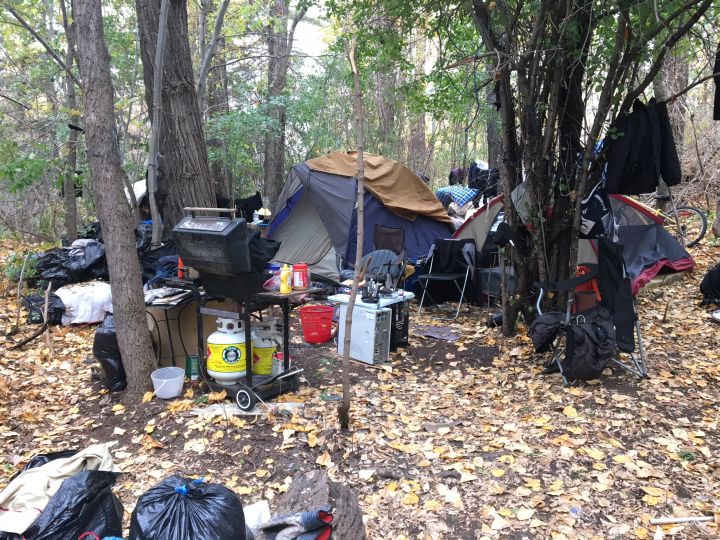For many wanting a good night’s sleep, camping out in the river valley is a better bet than hunkering down in a homeless shelter.

It’s the lesser of two evils for 486 individuals, according to a city report released Thursday ahead of next week’s May 8 Community and Public Services Committee meeting at City Hall.
The report is in response to an inquiry from Councillor Scott McKeen, who has heard a whole list of reasons emergency shelter beds go unused.
It documents that out of 1,923 people experiencing chronic homelessness, according to Homeward Trust, 486 individuals were identified as “sleeping rough,” 407 individuals were using emergency shelter services and 1,030 were provisionally accommodated either by staying with others, staying in interim or transitional housing or in institutional care.
“In the next four years, we want to build 600 units of permanent supportive housing,” McKeen told reporters after reviewing the findings.
“But that’s the next four years. What about this summer? What about next winter? And are there opportunities for some sort of modular or prefab units to be put up?”
He intends on raising that trailer option at the May 8 meeting.
“That would involve, I think, three orders of government.”
McKeen contends that the shelter system is broken for many reasons, including that many kick people out at 6 a.m.
Christel Kjenner, the city’s director of housing and homelessness — who was in Vancouver at the Urban Project conference looking into housing affordability — said the industry has identified five Ps that perpetuate the problem.

Get weekly health news
“People, Possessions, Pets, Policies and Pests,” she rhymed off, as individuals stay away fearing they’ll lose what little possessions they have, no shelters allow pets, they don’t like others who are there, or they don’t like how they’re treated by the institution.
A sixth P — for Partner — could be added to the list, Kjenner said, as couples have to be split up for the night since there are no co-ed shelters.
Of the 486 unsheltered individuals, 327 were men and approximately half self-identify as Indigenous, the report said.
McKeen believes if more secular facilities were made available, there would be more use.
“Given colonization, given the history of residential schools and the church’s involvement in that, Hope Mission is Christian-based, and from what I understand, not shy about proselytizing the people who are in there.”
Moving from faith-based service delivery is a trend that is emerging in the industry, Kjenner said.
“There’s well-trained staff and that sort of thing, and the entire sector overall in many ways is evolving into more of a professionalized social service model.”
WATCH: Edmonton police want drivers to think twice before handing over their spare change to panhandlers. Quinn Ohler reports.

According to the most recent stats, approximately 29 per cent of Edmonton’s emergency shelter beds were available on any given night in 2018. The majority of the 207 unused beds were provided by Hope Mission and serve single males.
Hope Mission intox shelter beds have consistently been at or over capacity over the past six years, while George Spady Society’s 60 overnight shelter spaces have consistently been at or over capacity over the past three years, according to the report.
As for costs, the report said camp clean-up efforts are estimated at $1.7 million a year. Calls to 311 are more frequent with 1,721 in 2018, roughly 600 more than a year prior and double that of 2016.
That, plus health care, policing and fire costs have convinced McKeen that Premier Jason Kenney could be swayed by black and white numbers that investing in supportive housing will more than pay for itself.
McKeen said the most recent estimates would have a seven-to-one payback if homelessness was treated as a medical issue, as those with chronic mental issues “self-medicate.”
“Unfortunately, we’re letting crime gangs do the prescribing and distribution instead of the medial system,” McKeen said. “We would see crime drop significantly because a lot of these people have to break into garages or homes, or steal bikes or prostitute themselves to get the money to buy drugs out of the black market, the illicit market.”
“I want to show [Premier Kenney] Ambrose Place, show him how it works. And there’s people living there who were living, believe me, under the most dire circumstances who have now returned to human form and functioning. But it’s saving a lot of money. And it’s an expensive permanent supportive housing facility. It ain’t cheap to run,” McKeen said.
Kjenner said of 91 current and former Ambrose Place residents, after they moved in, rates of emergency department visits decreased by 53 per cent, and the overall rates of hospital stays in in-patient beds dropped 64 per cent over the past two years.
McKeen said the savings could be in the tens of millions of dollars.






Comments